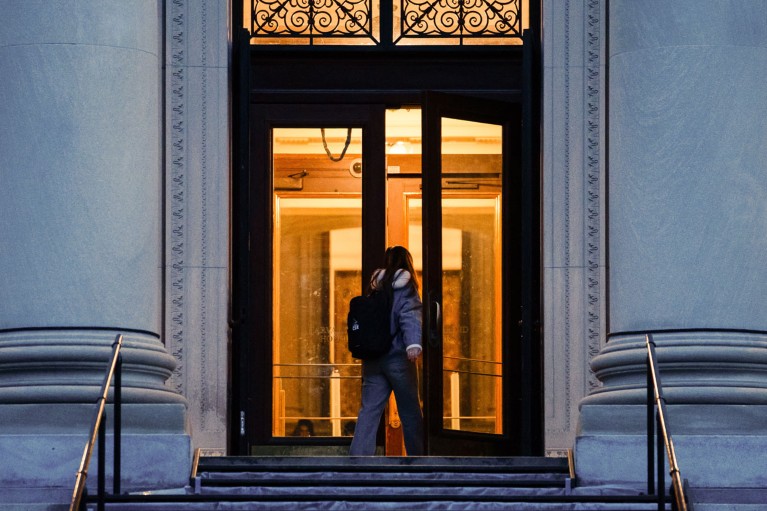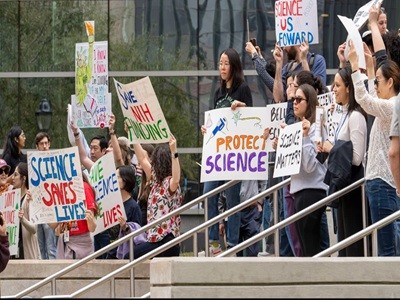- NEWS
US PhD admissions shrink as fears over Trump’s cuts take hold

Many academic departments at US universities are planning to cut the size of graduate-student cohorts.Credit: Sophie Park/Bloomberg/Getty
Phoenix-Avery Sarían has been interested in astronomy ever since her mother bought her a telescope as a child. But the fourth-year university student faces a cosmic challenge in reaching the next stage of her academic career: enrolling in a PhD programme.
Preliminary survey data show that dozens of US graduate programmes in astronomy and physics are planning to admit smaller PhD cohorts than usual for the next academic year — or even no graduate students at all. To compensate, Sarían, who is studying astronomy at Ohio State University in Columbus, is applying to more graduate schools than she’d originally planned, perhaps as many as 20.
Sarían is far from alone in her predicament. Across scientific disciplines, US university departments are cutting the numbers of PhD candidates they plan to accept in the current application cycle, for students due to begin in 2026. Some plan to pause admissions altogether. Programmes “in even some of the most elite among elite institutions are taking this step out of an abundance of caution”, says Julie Posselt at the University of Southern California in Los Angeles, who studies higher education. Harvard University in Cambridge, Massachusetts, for instance, is significantly cutting PhD admissions across a swathe of departments ― and cutting admissions in at least one science department by roughly 75%, according to a 20 October story in the student newspaper The Harvard Crimson.

These nations are wooing PhD students amid US funding uncertainties
The cutbacks are being driven by several factors, including institutional decisions about which research fields to support. But the reductions are due in large part to the US political environment, researchers say. Since Donald Trump became president in January, his administration has frozen billions of dollars in research funding at targeted institutions, including Brown University in Providence, Rhode Island, and Harvard; although some of this has been reinstated, large deficits and uncertainties remain. The administration has also proposed massive cuts in federal support for research infrastructure. Trump’s administration is now asking all US universities to support its priorities, which include a ban on diversity programmes, in exchange for better access to federal research monies.
Many researchers worry about the long-term effects of throttling the pipeline of trained scientists. “If this keeps up, it would be really devastating for the field, because this is where the next generation of experts comes from,” says Emily Levesque, an astronomer at the University of Washington in Seattle.
Nature asked the US Department of Education for comment, and received an automated reply saying the press office would not respond to queries until after the ongoing US government shutdown ends.
The turmoil continues
Earlier this year, many university departments slashed their incoming PhD classes in a last-minute scramble as the Trump administration began cutting research funds. Now they are trying to work out how many students they can accommodate in an uncertain future.
Few universities have revealed details of their graduate admissions plans for the 2026–27 academic year. But several grassroots surveys hint that broad cutbacks are in the works across both US institutions and research disciplines.
Levesque and her colleagues surveyed more than 150 US astronomy and physics graduate programmes, and found that at least 33 of the 91 respondents planned to admit fewer or no graduate students for the academic year starting in the second half of 2026.

Meet the early-career scientists planning to leave the United States
Meanwhile, 40 of the 45 biology departments that responded to a separate survey — sent to roughly 80 biology programmes — said that they had already shrunk their anticipated PhD cohorts for the 2026–27 academic year or planned to do so. Kimberly Cooper, a developmental biologist at the University of California, San Diego, instituted the survey to share information between those responsible for admitting PhD students. “We were having all these conversations about what we do, and making the decisions, all in isolation,” she says. The response was so overwhelming that departmental representatives now meet in a monthly video call to share their experiences.
One of the biology departments that has retrenched is at the Massachusetts Institute of Technology (MIT) in Cambridge. It admitted 24 PhD students this year, compared with 34 in 2024, says the department’s graduate officer Mary Gehring. The department might admit smaller numbers next year, as well, depending on the outcome of an upcoming decision from the US National Institutes of Health on its application for training funds. In the interim, a new philanthropic fund is helping to support graduate students in life sciences at MIT.
Some departments have cancelled PhD admissions for the current application cycle altogether. At the University of Washington, the astronomy department admitted an unexpectedly large PhD cohort for the 2025–26 academic year, Levesque says, because more students accepted admissions offers than anticipated. Faced with limited resources as a result of federal funding cuts, the department decided to pause PhD admissions for the 2026–27 academic year rather than have a tiny cohort. “There is no shortage of the Universe for us to work on, and there’s no shortage of people who want to work on it,” says Levesque. “It’s a frustrating bottleneck to be in.”
At Brown, the anthropology department chose to pause PhD admissions for the upcoming year in exchange for not cutting the incoming class, says department chair Jessaca Leinaweaver. Fewer graduate students will probably mean fewer graduate courses, and fewer opportunities for students to learn together and from one another, “which helps to forge vital informal mentoring networks that are very important to our student success and well-being”, Leinaweaver says.
Lasting effects
Even if PhD programmes rebound next year, the current cuts will have long-lasting effects, Posselt says. She had to shelve her own plans to support a PhD student and a postdoctoral fellow after losing a multi-year US National Science Foundation grant, which was terminated earlier this year when the Trump administration cancelled a raft of grants that it said were not aligned with its priorities. “It will have impacts for years to come unless I am able to identify additional funds,” she says.
Because graduate students perform much of the science done in university labs, “fewer graduate students mean less science will be produced”, says Donna Ginther, an economist at the University of Kansas in Lawrence. “If this persists for a number of years, the scientific workforce will shrink.” Fewer scientists overall will mean fewer scientific discoveries, she says.
doi: https://doi.org/10.1038/d41586-025-03417-6
The writer of this article does part-time book editing for the American Astronomical Society, which commissioned the survey of physics and astronomy departments described in this story.

 US brain drain: the scientists seeking jobs abroad amid Trump’s assault on research
US brain drain: the scientists seeking jobs abroad amid Trump’s assault on research Postdocs and PhD students hit hard by Trump’s crackdown on science
Postdocs and PhD students hit hard by Trump’s crackdown on science Hong Kong universities woo Harvard international students targeted by Trump
Hong Kong universities woo Harvard international students targeted by Trump ‘All this is in crisis’: US universities curtail staff and spending as Trump cuts take hold
‘All this is in crisis’: US universities curtail staff and spending as Trump cuts take hold

Comments
Post a Comment